Commercial Law Assignment: Negligence and Consumer Law Issues Analysis
VerifiedAdded on 2022/08/29
|11
|2662
|13
Report
AI Summary
This assignment report delves into two key areas of commercial law: negligence in tort and consumer law. The first part of the assignment examines a negligence case study, analyzing the elements required to establish negligence, including duty of care, breach of duty, causation, and damages. It references landmark cases like Donoghue v Stevenson, Liebeck v McDonald’s Restaurant, and Bolton v Stone to illustrate legal principles. The second part focuses on consumer law, specifically addressing product defects and consumer rights under the Australian Consumer Law (ACL). It analyzes a scenario involving defective appliances, exploring breaches of the ACL related to misleading conduct, guarantees, and the provision of spare parts. The report applies relevant legal provisions and case law to the given scenarios, offering a comprehensive understanding of both negligence and consumer protection within a commercial context.

Running head: COMMERCIAL LAW
COMMERCIAL LAW
Name of Student
Name of University
Author Note
COMMERCIAL LAW
Name of Student
Name of University
Author Note
Paraphrase This Document
Need a fresh take? Get an instant paraphrase of this document with our AI Paraphraser
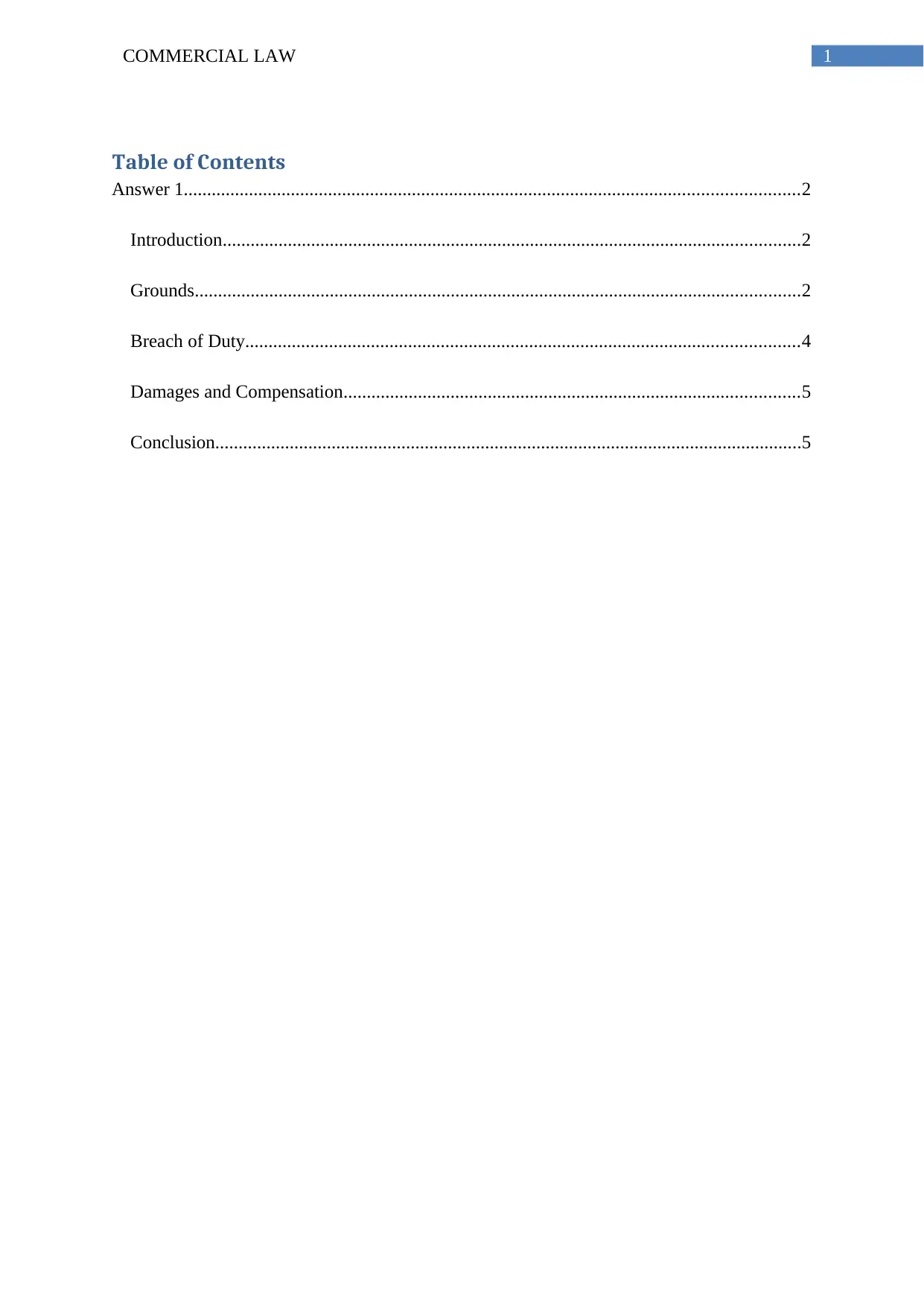
1COMMERCIAL LAW
Table of Contents
Answer 1....................................................................................................................................2
Introduction............................................................................................................................2
Grounds..................................................................................................................................2
Breach of Duty.......................................................................................................................4
Damages and Compensation..................................................................................................5
Conclusion..............................................................................................................................5
Table of Contents
Answer 1....................................................................................................................................2
Introduction............................................................................................................................2
Grounds..................................................................................................................................2
Breach of Duty.......................................................................................................................4
Damages and Compensation..................................................................................................5
Conclusion..............................................................................................................................5
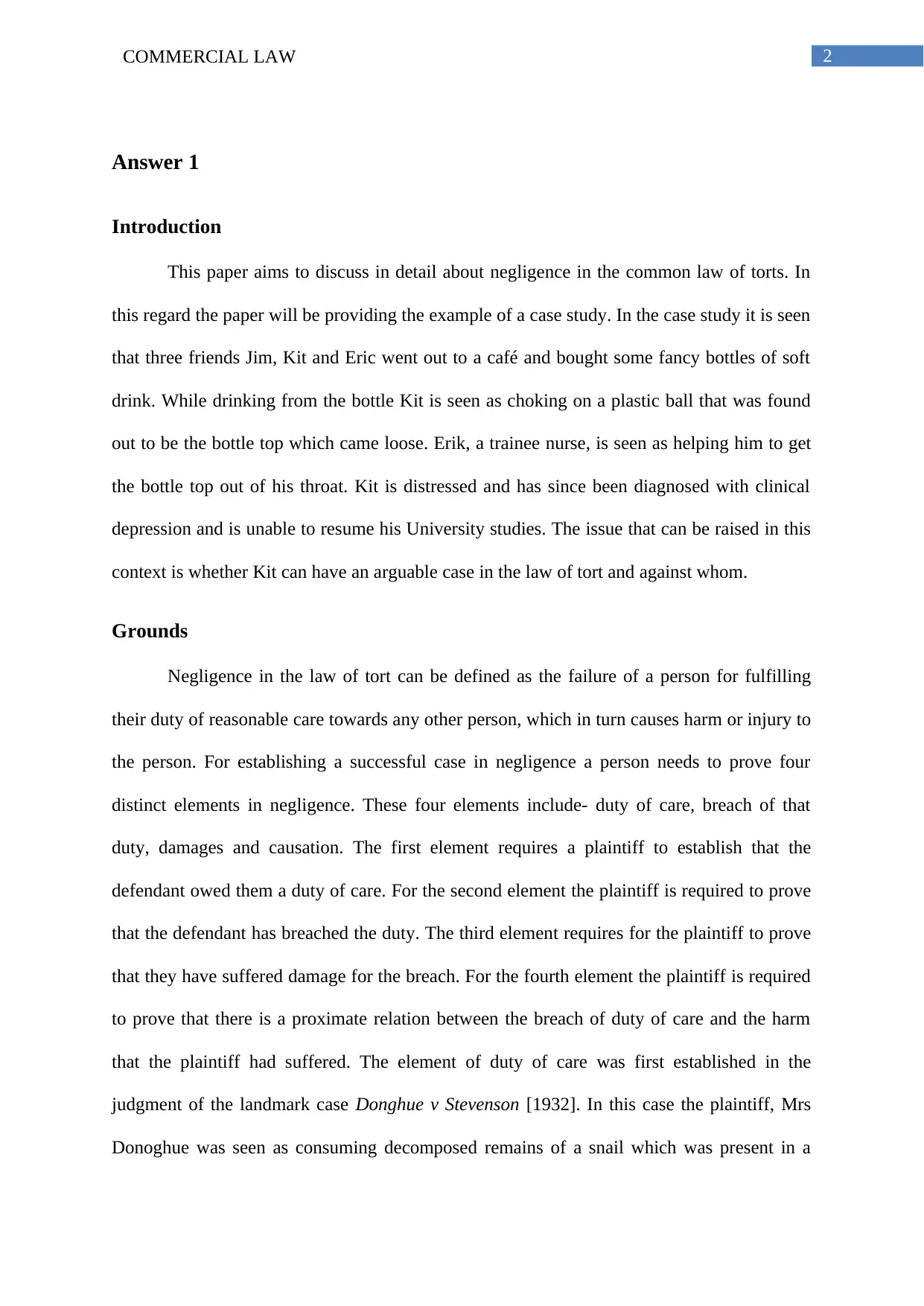
2COMMERCIAL LAW
Answer 1
Introduction
This paper aims to discuss in detail about negligence in the common law of torts. In
this regard the paper will be providing the example of a case study. In the case study it is seen
that three friends Jim, Kit and Eric went out to a café and bought some fancy bottles of soft
drink. While drinking from the bottle Kit is seen as choking on a plastic ball that was found
out to be the bottle top which came loose. Erik, a trainee nurse, is seen as helping him to get
the bottle top out of his throat. Kit is distressed and has since been diagnosed with clinical
depression and is unable to resume his University studies. The issue that can be raised in this
context is whether Kit can have an arguable case in the law of tort and against whom.
Grounds
Negligence in the law of tort can be defined as the failure of a person for fulfilling
their duty of reasonable care towards any other person, which in turn causes harm or injury to
the person. For establishing a successful case in negligence a person needs to prove four
distinct elements in negligence. These four elements include- duty of care, breach of that
duty, damages and causation. The first element requires a plaintiff to establish that the
defendant owed them a duty of care. For the second element the plaintiff is required to prove
that the defendant has breached the duty. The third element requires for the plaintiff to prove
that they have suffered damage for the breach. For the fourth element the plaintiff is required
to prove that there is a proximate relation between the breach of duty of care and the harm
that the plaintiff had suffered. The element of duty of care was first established in the
judgment of the landmark case Donghue v Stevenson [1932]. In this case the plaintiff, Mrs
Donoghue was seen as consuming decomposed remains of a snail which was present in a
Answer 1
Introduction
This paper aims to discuss in detail about negligence in the common law of torts. In
this regard the paper will be providing the example of a case study. In the case study it is seen
that three friends Jim, Kit and Eric went out to a café and bought some fancy bottles of soft
drink. While drinking from the bottle Kit is seen as choking on a plastic ball that was found
out to be the bottle top which came loose. Erik, a trainee nurse, is seen as helping him to get
the bottle top out of his throat. Kit is distressed and has since been diagnosed with clinical
depression and is unable to resume his University studies. The issue that can be raised in this
context is whether Kit can have an arguable case in the law of tort and against whom.
Grounds
Negligence in the law of tort can be defined as the failure of a person for fulfilling
their duty of reasonable care towards any other person, which in turn causes harm or injury to
the person. For establishing a successful case in negligence a person needs to prove four
distinct elements in negligence. These four elements include- duty of care, breach of that
duty, damages and causation. The first element requires a plaintiff to establish that the
defendant owed them a duty of care. For the second element the plaintiff is required to prove
that the defendant has breached the duty. The third element requires for the plaintiff to prove
that they have suffered damage for the breach. For the fourth element the plaintiff is required
to prove that there is a proximate relation between the breach of duty of care and the harm
that the plaintiff had suffered. The element of duty of care was first established in the
judgment of the landmark case Donghue v Stevenson [1932]. In this case the plaintiff, Mrs
Donoghue was seen as consuming decomposed remains of a snail which was present in a
⊘ This is a preview!⊘
Do you want full access?
Subscribe today to unlock all pages.

Trusted by 1+ million students worldwide
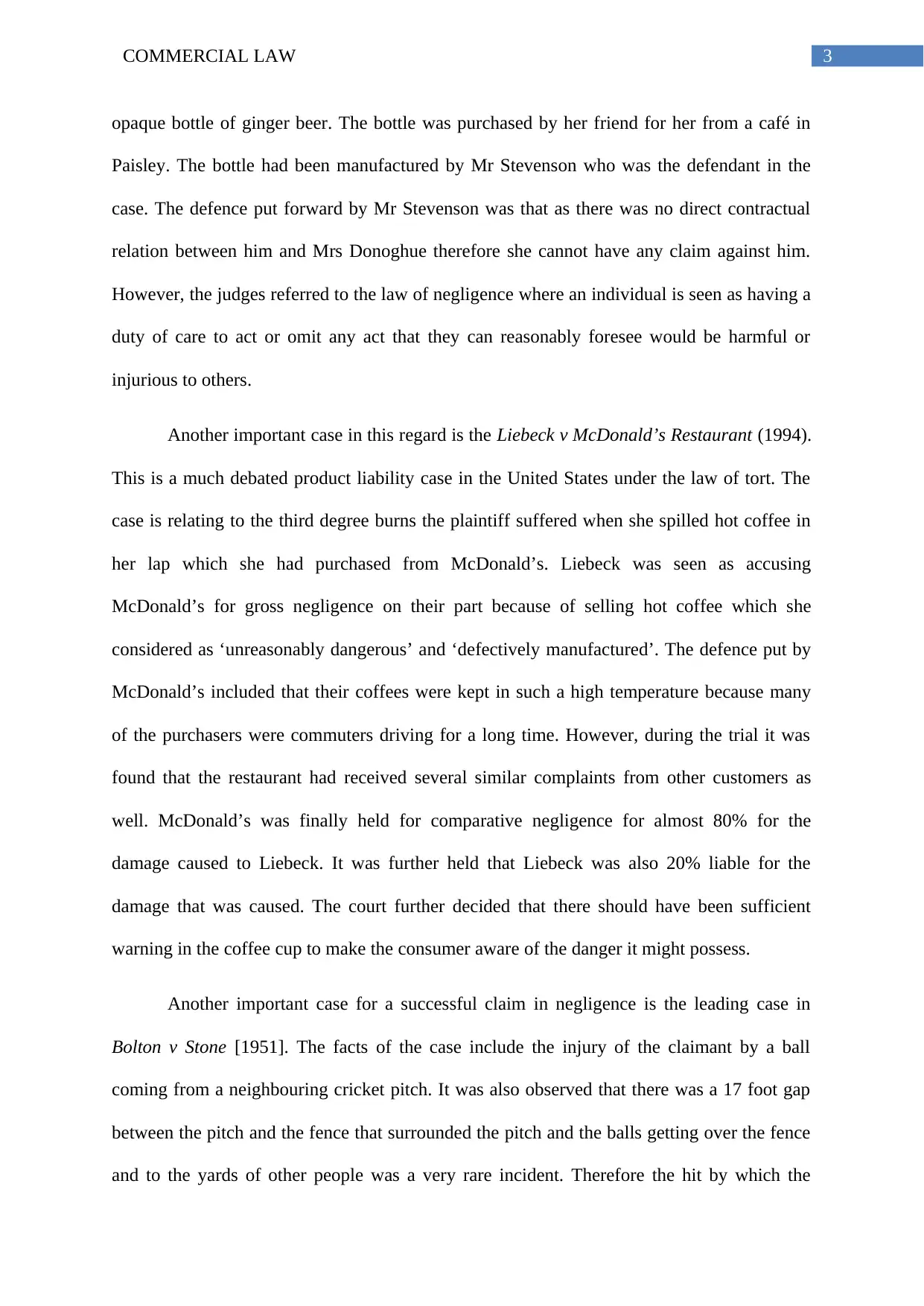
3COMMERCIAL LAW
opaque bottle of ginger beer. The bottle was purchased by her friend for her from a café in
Paisley. The bottle had been manufactured by Mr Stevenson who was the defendant in the
case. The defence put forward by Mr Stevenson was that as there was no direct contractual
relation between him and Mrs Donoghue therefore she cannot have any claim against him.
However, the judges referred to the law of negligence where an individual is seen as having a
duty of care to act or omit any act that they can reasonably foresee would be harmful or
injurious to others.
Another important case in this regard is the Liebeck v McDonald’s Restaurant (1994).
This is a much debated product liability case in the United States under the law of tort. The
case is relating to the third degree burns the plaintiff suffered when she spilled hot coffee in
her lap which she had purchased from McDonald’s. Liebeck was seen as accusing
McDonald’s for gross negligence on their part because of selling hot coffee which she
considered as ‘unreasonably dangerous’ and ‘defectively manufactured’. The defence put by
McDonald’s included that their coffees were kept in such a high temperature because many
of the purchasers were commuters driving for a long time. However, during the trial it was
found that the restaurant had received several similar complaints from other customers as
well. McDonald’s was finally held for comparative negligence for almost 80% for the
damage caused to Liebeck. It was further held that Liebeck was also 20% liable for the
damage that was caused. The court further decided that there should have been sufficient
warning in the coffee cup to make the consumer aware of the danger it might possess.
Another important case for a successful claim in negligence is the leading case in
Bolton v Stone [1951]. The facts of the case include the injury of the claimant by a ball
coming from a neighbouring cricket pitch. It was also observed that there was a 17 foot gap
between the pitch and the fence that surrounded the pitch and the balls getting over the fence
and to the yards of other people was a very rare incident. Therefore the hit by which the
opaque bottle of ginger beer. The bottle was purchased by her friend for her from a café in
Paisley. The bottle had been manufactured by Mr Stevenson who was the defendant in the
case. The defence put forward by Mr Stevenson was that as there was no direct contractual
relation between him and Mrs Donoghue therefore she cannot have any claim against him.
However, the judges referred to the law of negligence where an individual is seen as having a
duty of care to act or omit any act that they can reasonably foresee would be harmful or
injurious to others.
Another important case in this regard is the Liebeck v McDonald’s Restaurant (1994).
This is a much debated product liability case in the United States under the law of tort. The
case is relating to the third degree burns the plaintiff suffered when she spilled hot coffee in
her lap which she had purchased from McDonald’s. Liebeck was seen as accusing
McDonald’s for gross negligence on their part because of selling hot coffee which she
considered as ‘unreasonably dangerous’ and ‘defectively manufactured’. The defence put by
McDonald’s included that their coffees were kept in such a high temperature because many
of the purchasers were commuters driving for a long time. However, during the trial it was
found that the restaurant had received several similar complaints from other customers as
well. McDonald’s was finally held for comparative negligence for almost 80% for the
damage caused to Liebeck. It was further held that Liebeck was also 20% liable for the
damage that was caused. The court further decided that there should have been sufficient
warning in the coffee cup to make the consumer aware of the danger it might possess.
Another important case for a successful claim in negligence is the leading case in
Bolton v Stone [1951]. The facts of the case include the injury of the claimant by a ball
coming from a neighbouring cricket pitch. It was also observed that there was a 17 foot gap
between the pitch and the fence that surrounded the pitch and the balls getting over the fence
and to the yards of other people was a very rare incident. Therefore the hit by which the
Paraphrase This Document
Need a fresh take? Get an instant paraphrase of this document with our AI Paraphraser
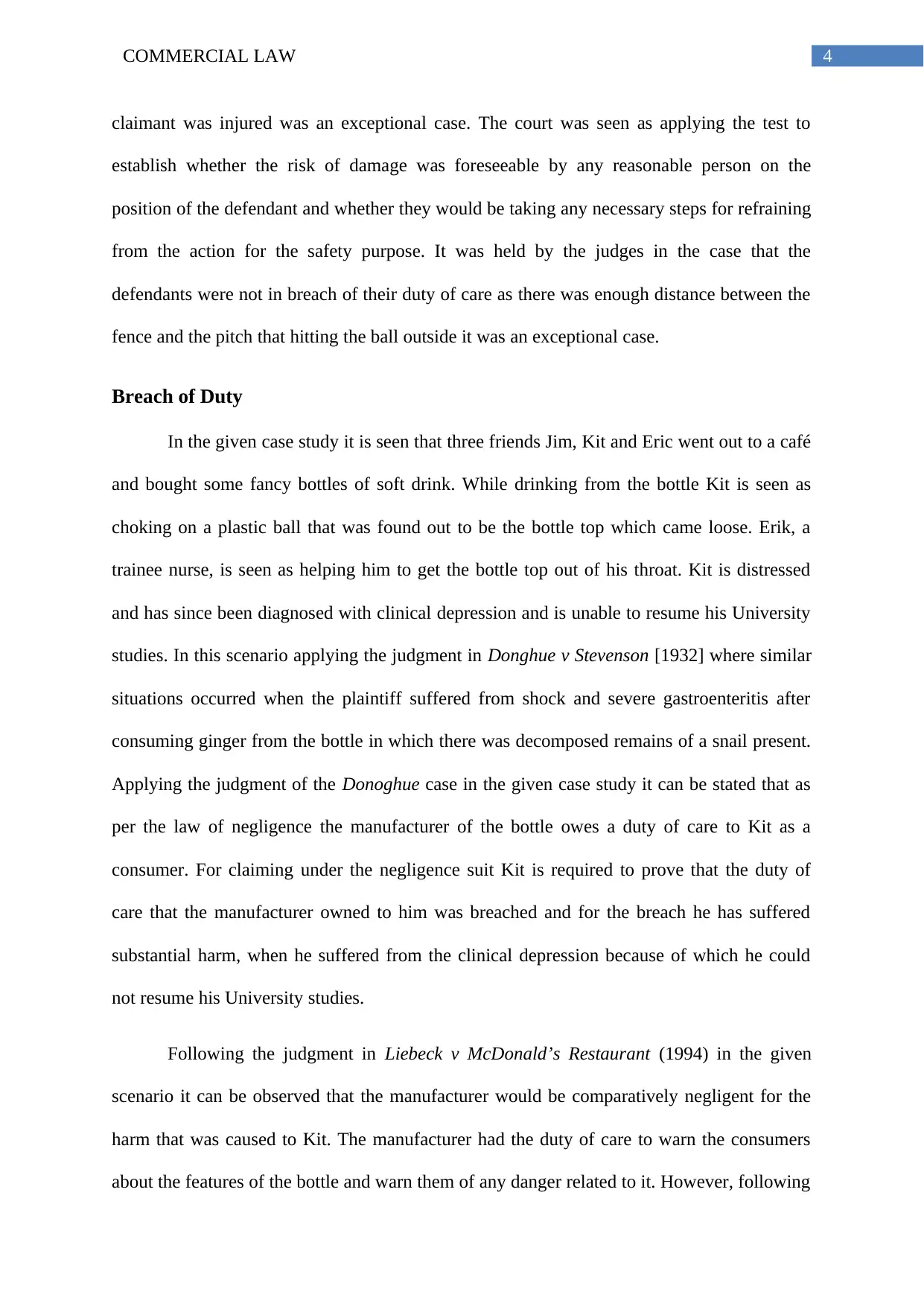
4COMMERCIAL LAW
claimant was injured was an exceptional case. The court was seen as applying the test to
establish whether the risk of damage was foreseeable by any reasonable person on the
position of the defendant and whether they would be taking any necessary steps for refraining
from the action for the safety purpose. It was held by the judges in the case that the
defendants were not in breach of their duty of care as there was enough distance between the
fence and the pitch that hitting the ball outside it was an exceptional case.
Breach of Duty
In the given case study it is seen that three friends Jim, Kit and Eric went out to a café
and bought some fancy bottles of soft drink. While drinking from the bottle Kit is seen as
choking on a plastic ball that was found out to be the bottle top which came loose. Erik, a
trainee nurse, is seen as helping him to get the bottle top out of his throat. Kit is distressed
and has since been diagnosed with clinical depression and is unable to resume his University
studies. In this scenario applying the judgment in Donghue v Stevenson [1932] where similar
situations occurred when the plaintiff suffered from shock and severe gastroenteritis after
consuming ginger from the bottle in which there was decomposed remains of a snail present.
Applying the judgment of the Donoghue case in the given case study it can be stated that as
per the law of negligence the manufacturer of the bottle owes a duty of care to Kit as a
consumer. For claiming under the negligence suit Kit is required to prove that the duty of
care that the manufacturer owned to him was breached and for the breach he has suffered
substantial harm, when he suffered from the clinical depression because of which he could
not resume his University studies.
Following the judgment in Liebeck v McDonald’s Restaurant (1994) in the given
scenario it can be observed that the manufacturer would be comparatively negligent for the
harm that was caused to Kit. The manufacturer had the duty of care to warn the consumers
about the features of the bottle and warn them of any danger related to it. However, following
claimant was injured was an exceptional case. The court was seen as applying the test to
establish whether the risk of damage was foreseeable by any reasonable person on the
position of the defendant and whether they would be taking any necessary steps for refraining
from the action for the safety purpose. It was held by the judges in the case that the
defendants were not in breach of their duty of care as there was enough distance between the
fence and the pitch that hitting the ball outside it was an exceptional case.
Breach of Duty
In the given case study it is seen that three friends Jim, Kit and Eric went out to a café
and bought some fancy bottles of soft drink. While drinking from the bottle Kit is seen as
choking on a plastic ball that was found out to be the bottle top which came loose. Erik, a
trainee nurse, is seen as helping him to get the bottle top out of his throat. Kit is distressed
and has since been diagnosed with clinical depression and is unable to resume his University
studies. In this scenario applying the judgment in Donghue v Stevenson [1932] where similar
situations occurred when the plaintiff suffered from shock and severe gastroenteritis after
consuming ginger from the bottle in which there was decomposed remains of a snail present.
Applying the judgment of the Donoghue case in the given case study it can be stated that as
per the law of negligence the manufacturer of the bottle owes a duty of care to Kit as a
consumer. For claiming under the negligence suit Kit is required to prove that the duty of
care that the manufacturer owned to him was breached and for the breach he has suffered
substantial harm, when he suffered from the clinical depression because of which he could
not resume his University studies.
Following the judgment in Liebeck v McDonald’s Restaurant (1994) in the given
scenario it can be observed that the manufacturer would be comparatively negligent for the
harm that was caused to Kit. The manufacturer had the duty of care to warn the consumers
about the features of the bottle and warn them of any danger related to it. However, following

5COMMERCIAL LAW
the Liebeck judgment in the given scenario it can be said that Kit was also partially
responsible for his injury. As a reasonable person he was also required to be acting in a
cautious way while drinking from the bottle.
Following the Bolton v Stone [1951] judgment in the given scenario it is required to
establish whether the risk of damage was foreseeable by any reasonable person on the
position of the defendant and whether they would be taking any necessary steps for refraining
from the action for the safety purpose. As there was small plastic ball which is reasonable to
believe would come loose and some people might choke on it while drinking from the bottle
therefore it can be said that the manufacturers have a duty of care towards the consumers. As
there was no necessary steps taken by the manufacturers to warn the consumers of the
potential harm that might arise from the bottle, they would be considered as breaching the
duty of care they owe.
Damages and Compensation
In the case, because of the incident Kit is seen as suffering from clinical depression
and has also missed his University studies. He can claim for the compensation equivalent to
the damages he has suffered.
Conclusion
Thus in conclusion it can be stated that Kit can have a successful negligence case
against the manufacturers of the bottle.
Answer 2
Introduction
In the given scenario it can be observed that from the tax refund cheque that Max
received, he wants to buy some new appliances for his wife, Anna. The first thing he buys is
the Liebeck judgment in the given scenario it can be said that Kit was also partially
responsible for his injury. As a reasonable person he was also required to be acting in a
cautious way while drinking from the bottle.
Following the Bolton v Stone [1951] judgment in the given scenario it is required to
establish whether the risk of damage was foreseeable by any reasonable person on the
position of the defendant and whether they would be taking any necessary steps for refraining
from the action for the safety purpose. As there was small plastic ball which is reasonable to
believe would come loose and some people might choke on it while drinking from the bottle
therefore it can be said that the manufacturers have a duty of care towards the consumers. As
there was no necessary steps taken by the manufacturers to warn the consumers of the
potential harm that might arise from the bottle, they would be considered as breaching the
duty of care they owe.
Damages and Compensation
In the case, because of the incident Kit is seen as suffering from clinical depression
and has also missed his University studies. He can claim for the compensation equivalent to
the damages he has suffered.
Conclusion
Thus in conclusion it can be stated that Kit can have a successful negligence case
against the manufacturers of the bottle.
Answer 2
Introduction
In the given scenario it can be observed that from the tax refund cheque that Max
received, he wants to buy some new appliances for his wife, Anna. The first thing he buys is
⊘ This is a preview!⊘
Do you want full access?
Subscribe today to unlock all pages.

Trusted by 1+ million students worldwide
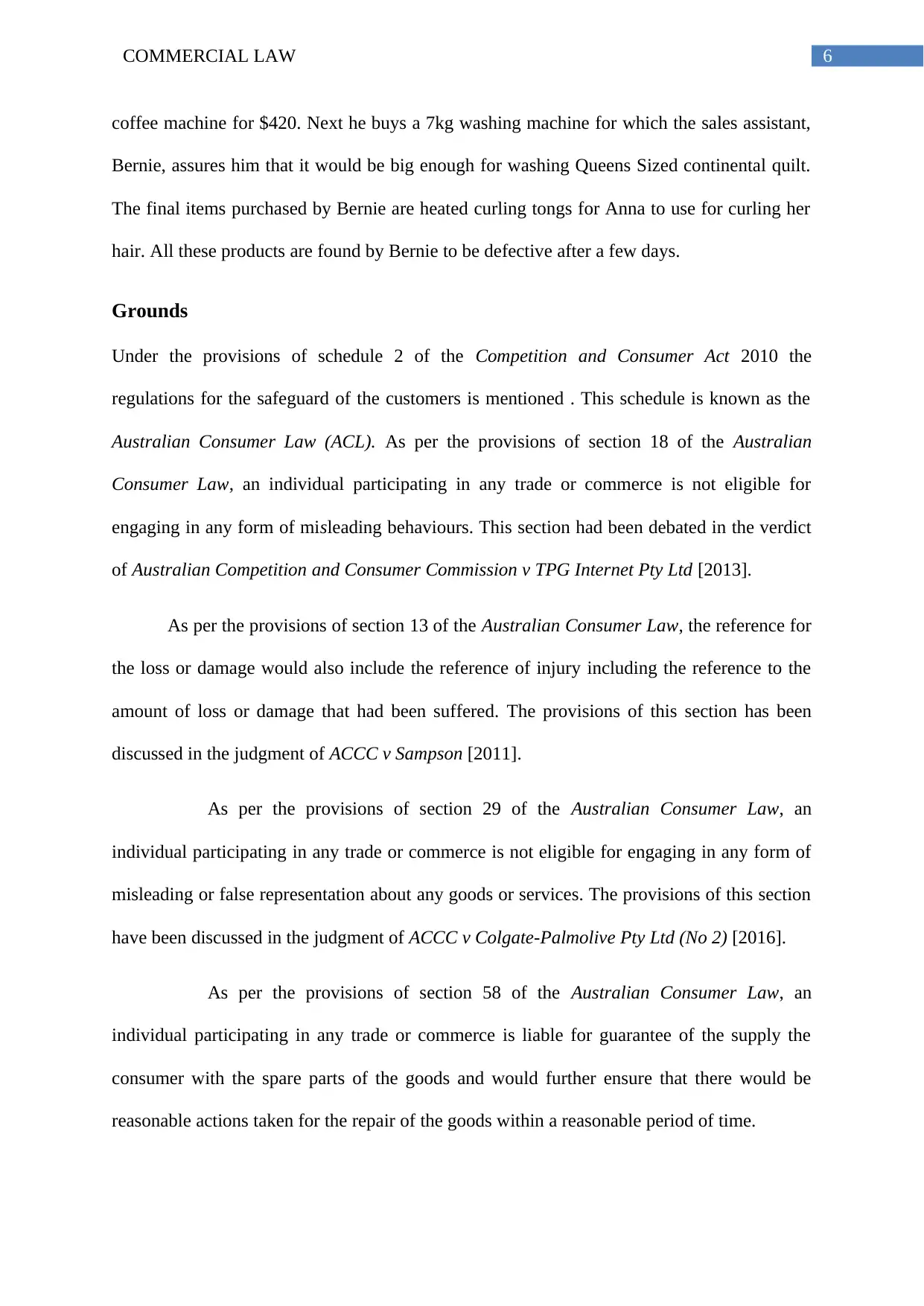
6COMMERCIAL LAW
coffee machine for $420. Next he buys a 7kg washing machine for which the sales assistant,
Bernie, assures him that it would be big enough for washing Queens Sized continental quilt.
The final items purchased by Bernie are heated curling tongs for Anna to use for curling her
hair. All these products are found by Bernie to be defective after a few days.
Grounds
Under the provisions of schedule 2 of the Competition and Consumer Act 2010 the
regulations for the safeguard of the customers is mentioned . This schedule is known as the
Australian Consumer Law (ACL). As per the provisions of section 18 of the Australian
Consumer Law, an individual participating in any trade or commerce is not eligible for
engaging in any form of misleading behaviours. This section had been debated in the verdict
of Australian Competition and Consumer Commission v TPG Internet Pty Ltd [2013].
As per the provisions of section 13 of the Australian Consumer Law, the reference for
the loss or damage would also include the reference of injury including the reference to the
amount of loss or damage that had been suffered. The provisions of this section has been
discussed in the judgment of ACCC v Sampson [2011].
As per the provisions of section 29 of the Australian Consumer Law, an
individual participating in any trade or commerce is not eligible for engaging in any form of
misleading or false representation about any goods or services. The provisions of this section
have been discussed in the judgment of ACCC v Colgate-Palmolive Pty Ltd (No 2) [2016].
As per the provisions of section 58 of the Australian Consumer Law, an
individual participating in any trade or commerce is liable for guarantee of the supply the
consumer with the spare parts of the goods and would further ensure that there would be
reasonable actions taken for the repair of the goods within a reasonable period of time.
coffee machine for $420. Next he buys a 7kg washing machine for which the sales assistant,
Bernie, assures him that it would be big enough for washing Queens Sized continental quilt.
The final items purchased by Bernie are heated curling tongs for Anna to use for curling her
hair. All these products are found by Bernie to be defective after a few days.
Grounds
Under the provisions of schedule 2 of the Competition and Consumer Act 2010 the
regulations for the safeguard of the customers is mentioned . This schedule is known as the
Australian Consumer Law (ACL). As per the provisions of section 18 of the Australian
Consumer Law, an individual participating in any trade or commerce is not eligible for
engaging in any form of misleading behaviours. This section had been debated in the verdict
of Australian Competition and Consumer Commission v TPG Internet Pty Ltd [2013].
As per the provisions of section 13 of the Australian Consumer Law, the reference for
the loss or damage would also include the reference of injury including the reference to the
amount of loss or damage that had been suffered. The provisions of this section has been
discussed in the judgment of ACCC v Sampson [2011].
As per the provisions of section 29 of the Australian Consumer Law, an
individual participating in any trade or commerce is not eligible for engaging in any form of
misleading or false representation about any goods or services. The provisions of this section
have been discussed in the judgment of ACCC v Colgate-Palmolive Pty Ltd (No 2) [2016].
As per the provisions of section 58 of the Australian Consumer Law, an
individual participating in any trade or commerce is liable for guarantee of the supply the
consumer with the spare parts of the goods and would further ensure that there would be
reasonable actions taken for the repair of the goods within a reasonable period of time.
Paraphrase This Document
Need a fresh take? Get an instant paraphrase of this document with our AI Paraphraser
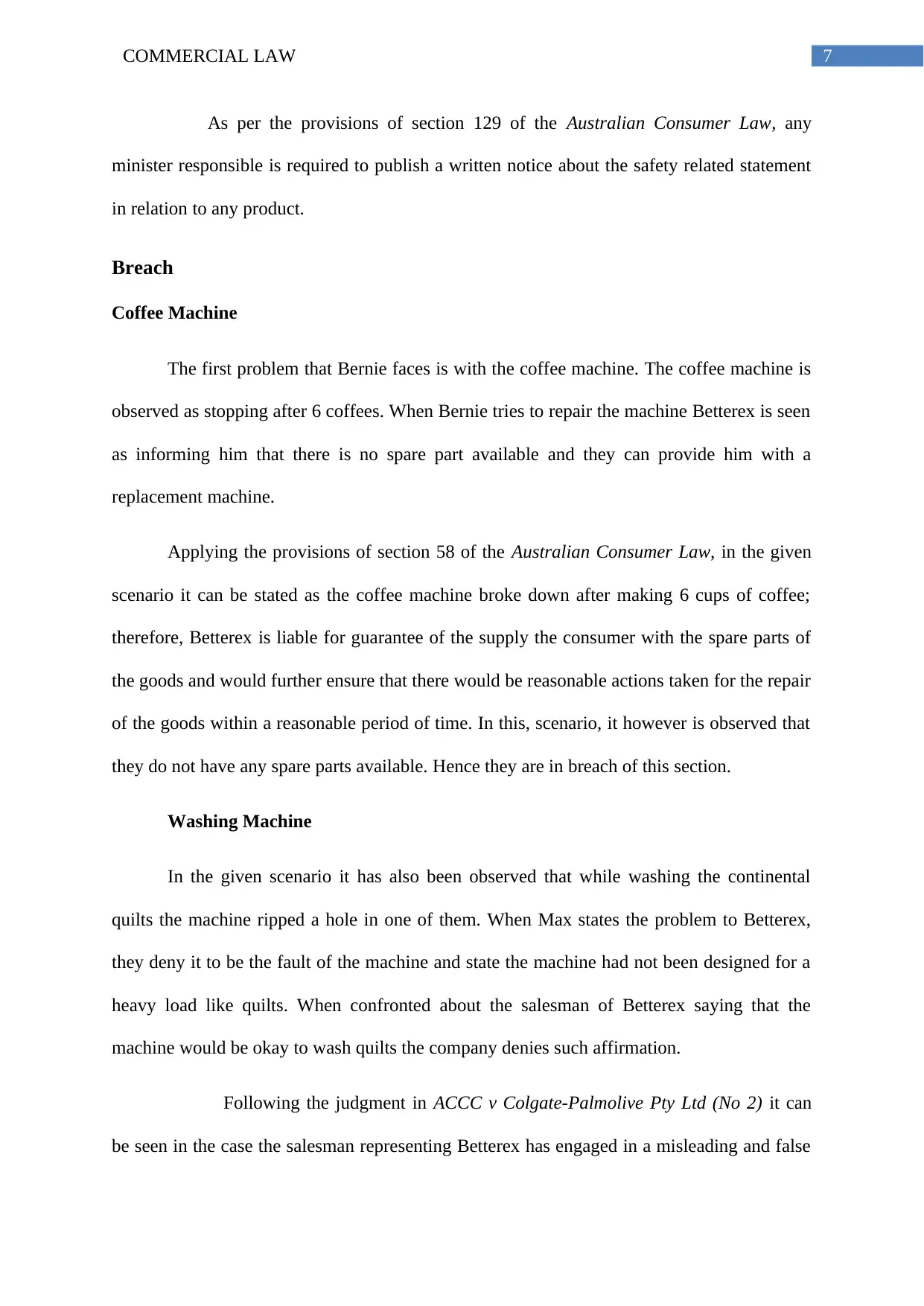
7COMMERCIAL LAW
As per the provisions of section 129 of the Australian Consumer Law, any
minister responsible is required to publish a written notice about the safety related statement
in relation to any product.
Breach
Coffee Machine
The first problem that Bernie faces is with the coffee machine. The coffee machine is
observed as stopping after 6 coffees. When Bernie tries to repair the machine Betterex is seen
as informing him that there is no spare part available and they can provide him with a
replacement machine.
Applying the provisions of section 58 of the Australian Consumer Law, in the given
scenario it can be stated as the coffee machine broke down after making 6 cups of coffee;
therefore, Betterex is liable for guarantee of the supply the consumer with the spare parts of
the goods and would further ensure that there would be reasonable actions taken for the repair
of the goods within a reasonable period of time. In this, scenario, it however is observed that
they do not have any spare parts available. Hence they are in breach of this section.
Washing Machine
In the given scenario it has also been observed that while washing the continental
quilts the machine ripped a hole in one of them. When Max states the problem to Betterex,
they deny it to be the fault of the machine and state the machine had not been designed for a
heavy load like quilts. When confronted about the salesman of Betterex saying that the
machine would be okay to wash quilts the company denies such affirmation.
Following the judgment in ACCC v Colgate-Palmolive Pty Ltd (No 2) it can
be seen in the case the salesman representing Betterex has engaged in a misleading and false
As per the provisions of section 129 of the Australian Consumer Law, any
minister responsible is required to publish a written notice about the safety related statement
in relation to any product.
Breach
Coffee Machine
The first problem that Bernie faces is with the coffee machine. The coffee machine is
observed as stopping after 6 coffees. When Bernie tries to repair the machine Betterex is seen
as informing him that there is no spare part available and they can provide him with a
replacement machine.
Applying the provisions of section 58 of the Australian Consumer Law, in the given
scenario it can be stated as the coffee machine broke down after making 6 cups of coffee;
therefore, Betterex is liable for guarantee of the supply the consumer with the spare parts of
the goods and would further ensure that there would be reasonable actions taken for the repair
of the goods within a reasonable period of time. In this, scenario, it however is observed that
they do not have any spare parts available. Hence they are in breach of this section.
Washing Machine
In the given scenario it has also been observed that while washing the continental
quilts the machine ripped a hole in one of them. When Max states the problem to Betterex,
they deny it to be the fault of the machine and state the machine had not been designed for a
heavy load like quilts. When confronted about the salesman of Betterex saying that the
machine would be okay to wash quilts the company denies such affirmation.
Following the judgment in ACCC v Colgate-Palmolive Pty Ltd (No 2) it can
be seen in the case the salesman representing Betterex has engaged in a misleading and false
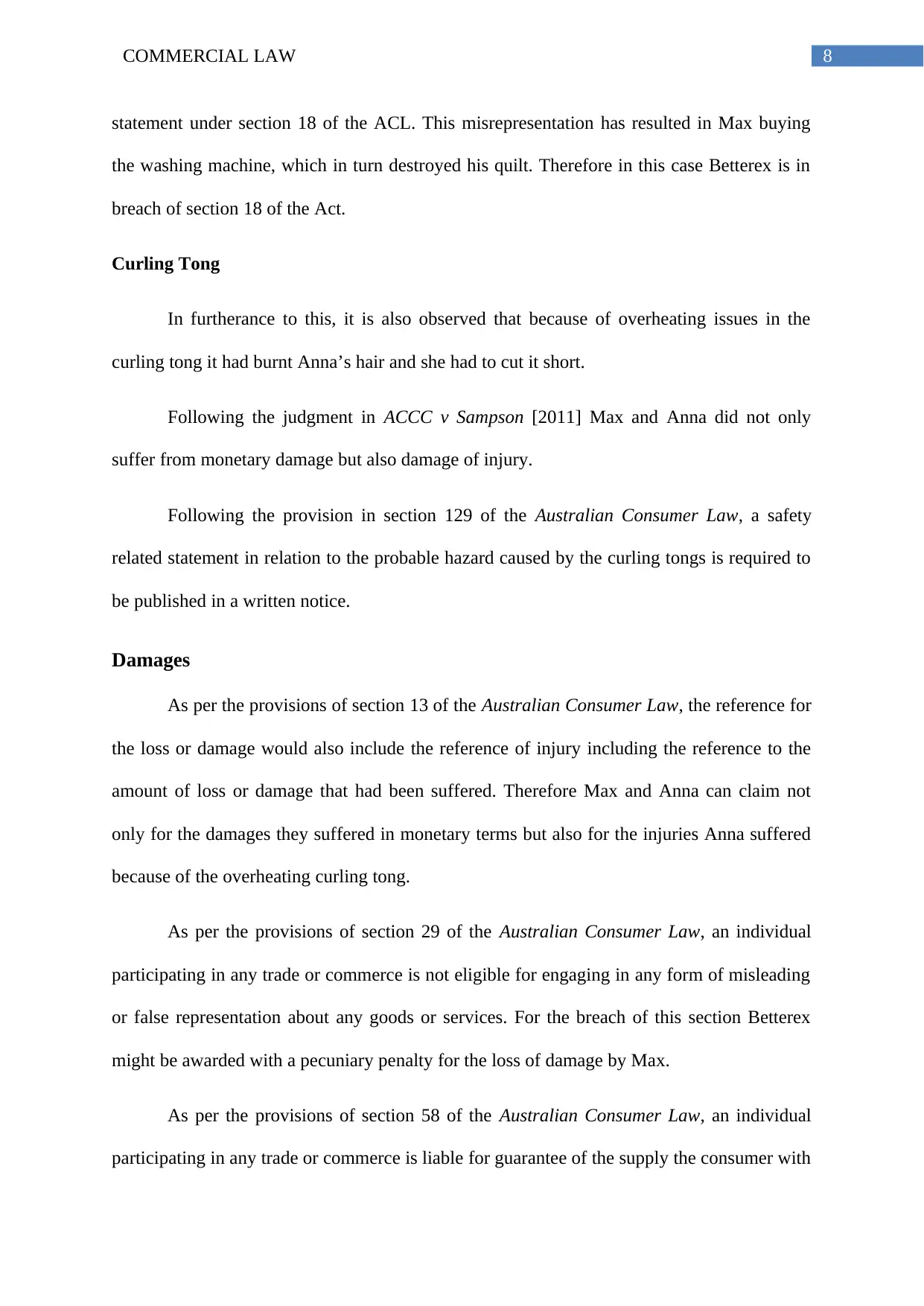
8COMMERCIAL LAW
statement under section 18 of the ACL. This misrepresentation has resulted in Max buying
the washing machine, which in turn destroyed his quilt. Therefore in this case Betterex is in
breach of section 18 of the Act.
Curling Tong
In furtherance to this, it is also observed that because of overheating issues in the
curling tong it had burnt Anna’s hair and she had to cut it short.
Following the judgment in ACCC v Sampson [2011] Max and Anna did not only
suffer from monetary damage but also damage of injury.
Following the provision in section 129 of the Australian Consumer Law, a safety
related statement in relation to the probable hazard caused by the curling tongs is required to
be published in a written notice.
Damages
As per the provisions of section 13 of the Australian Consumer Law, the reference for
the loss or damage would also include the reference of injury including the reference to the
amount of loss or damage that had been suffered. Therefore Max and Anna can claim not
only for the damages they suffered in monetary terms but also for the injuries Anna suffered
because of the overheating curling tong.
As per the provisions of section 29 of the Australian Consumer Law, an individual
participating in any trade or commerce is not eligible for engaging in any form of misleading
or false representation about any goods or services. For the breach of this section Betterex
might be awarded with a pecuniary penalty for the loss of damage by Max.
As per the provisions of section 58 of the Australian Consumer Law, an individual
participating in any trade or commerce is liable for guarantee of the supply the consumer with
statement under section 18 of the ACL. This misrepresentation has resulted in Max buying
the washing machine, which in turn destroyed his quilt. Therefore in this case Betterex is in
breach of section 18 of the Act.
Curling Tong
In furtherance to this, it is also observed that because of overheating issues in the
curling tong it had burnt Anna’s hair and she had to cut it short.
Following the judgment in ACCC v Sampson [2011] Max and Anna did not only
suffer from monetary damage but also damage of injury.
Following the provision in section 129 of the Australian Consumer Law, a safety
related statement in relation to the probable hazard caused by the curling tongs is required to
be published in a written notice.
Damages
As per the provisions of section 13 of the Australian Consumer Law, the reference for
the loss or damage would also include the reference of injury including the reference to the
amount of loss or damage that had been suffered. Therefore Max and Anna can claim not
only for the damages they suffered in monetary terms but also for the injuries Anna suffered
because of the overheating curling tong.
As per the provisions of section 29 of the Australian Consumer Law, an individual
participating in any trade or commerce is not eligible for engaging in any form of misleading
or false representation about any goods or services. For the breach of this section Betterex
might be awarded with a pecuniary penalty for the loss of damage by Max.
As per the provisions of section 58 of the Australian Consumer Law, an individual
participating in any trade or commerce is liable for guarantee of the supply the consumer with
⊘ This is a preview!⊘
Do you want full access?
Subscribe today to unlock all pages.

Trusted by 1+ million students worldwide
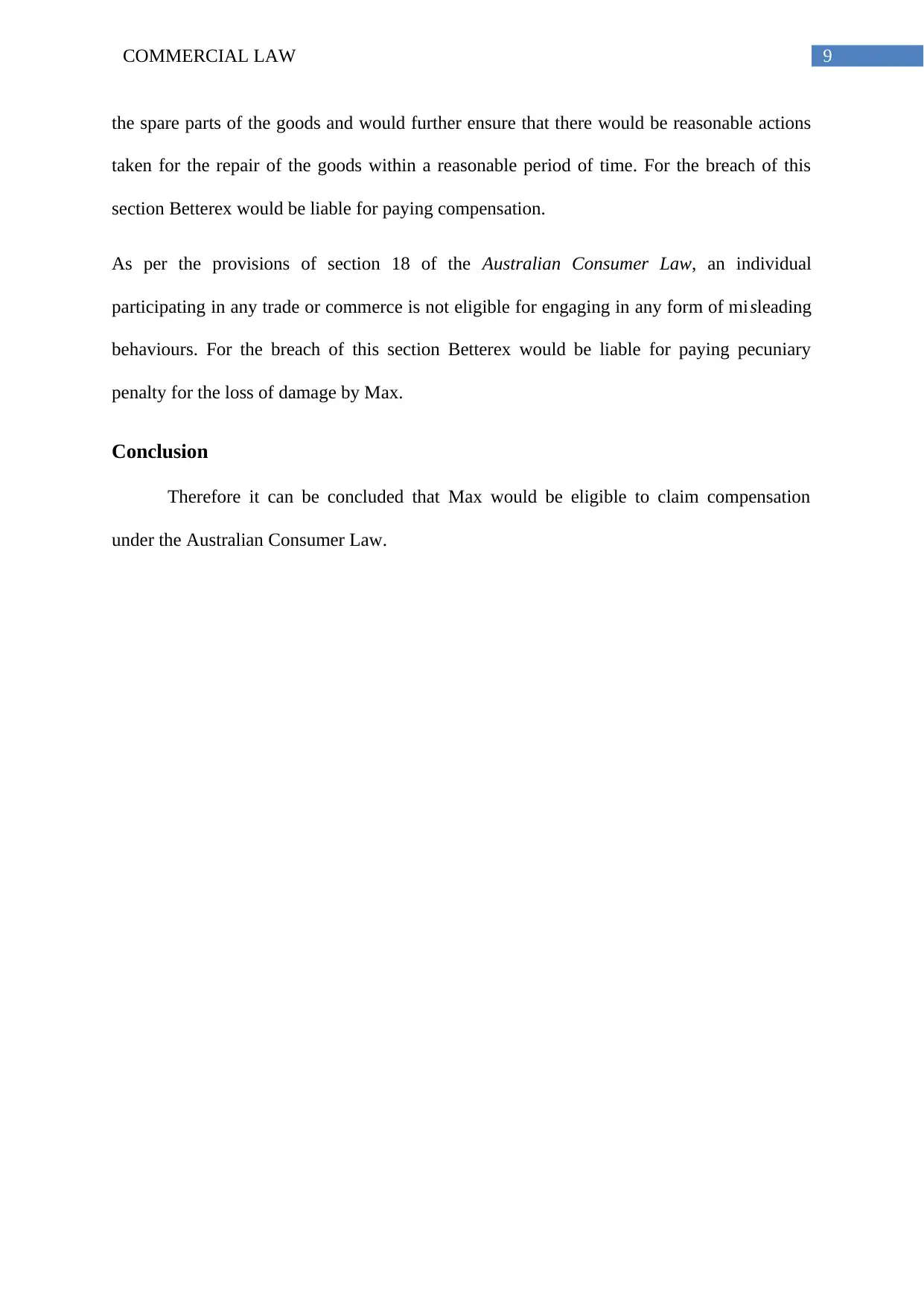
9COMMERCIAL LAW
the spare parts of the goods and would further ensure that there would be reasonable actions
taken for the repair of the goods within a reasonable period of time. For the breach of this
section Betterex would be liable for paying compensation.
As per the provisions of section 18 of the Australian Consumer Law, an individual
participating in any trade or commerce is not eligible for engaging in any form of misleading
behaviours. For the breach of this section Betterex would be liable for paying pecuniary
penalty for the loss of damage by Max.
Conclusion
Therefore it can be concluded that Max would be eligible to claim compensation
under the Australian Consumer Law.
the spare parts of the goods and would further ensure that there would be reasonable actions
taken for the repair of the goods within a reasonable period of time. For the breach of this
section Betterex would be liable for paying compensation.
As per the provisions of section 18 of the Australian Consumer Law, an individual
participating in any trade or commerce is not eligible for engaging in any form of misleading
behaviours. For the breach of this section Betterex would be liable for paying pecuniary
penalty for the loss of damage by Max.
Conclusion
Therefore it can be concluded that Max would be eligible to claim compensation
under the Australian Consumer Law.
Paraphrase This Document
Need a fresh take? Get an instant paraphrase of this document with our AI Paraphraser
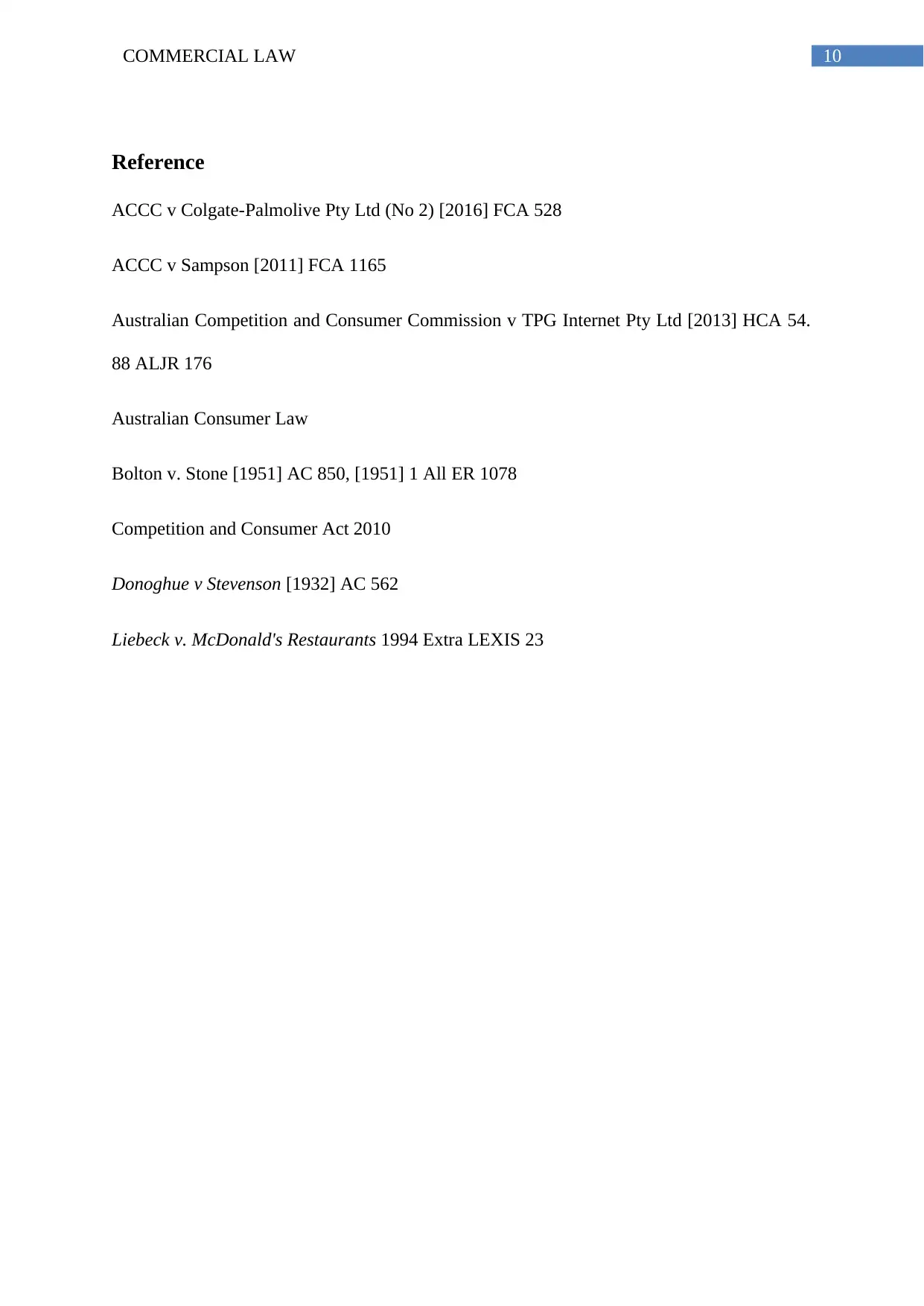
10COMMERCIAL LAW
Reference
ACCC v Colgate-Palmolive Pty Ltd (No 2) [2016] FCA 528
ACCC v Sampson [2011] FCA 1165
Australian Competition and Consumer Commission v TPG Internet Pty Ltd [2013] HCA 54.
88 ALJR 176
Australian Consumer Law
Bolton v. Stone [1951] AC 850, [1951] 1 All ER 1078
Competition and Consumer Act 2010
Donoghue v Stevenson [1932] AC 562
Liebeck v. McDonald's Restaurants 1994 Extra LEXIS 23
Reference
ACCC v Colgate-Palmolive Pty Ltd (No 2) [2016] FCA 528
ACCC v Sampson [2011] FCA 1165
Australian Competition and Consumer Commission v TPG Internet Pty Ltd [2013] HCA 54.
88 ALJR 176
Australian Consumer Law
Bolton v. Stone [1951] AC 850, [1951] 1 All ER 1078
Competition and Consumer Act 2010
Donoghue v Stevenson [1932] AC 562
Liebeck v. McDonald's Restaurants 1994 Extra LEXIS 23
1 out of 11
Related Documents
Your All-in-One AI-Powered Toolkit for Academic Success.
+13062052269
info@desklib.com
Available 24*7 on WhatsApp / Email
![[object Object]](/_next/static/media/star-bottom.7253800d.svg)
Unlock your academic potential
Copyright © 2020–2025 A2Z Services. All Rights Reserved. Developed and managed by ZUCOL.





